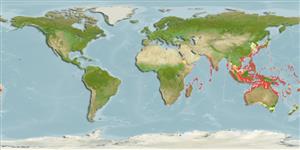Environment: milieu / climate zone / depth range / distribution range
Écologie
marin récifal; profondeur 1 - 55 m (Ref. 9710). Subtropical
Indo-West Pacific: tropical and subtropical waters, South Africa eastward through Indonesia; northward to southern Japan; southward to the east coast of Australia (Ref. 33352). Southeast Atlantic: south coast of South Africa.
Taille / Poids / Âge
Maturity: Lm ? range ? - ? cm
Max length : 19.0 cm TL mâle / non sexé; (Ref. 9710)
Description synthétique
Clés d'identification | Morphologie | Morphométrie
Épines dorsales (Total) : 2; Rayons mous dorsaux (Total) : 43 - 50; Épines anales: 0; Rayons mous anaux: 41 - 46. Pale brown to grey in color; two brown stripes on body; adults with yellow spots on head and body; soft dorsal and anal fins yellowish; caudal fin dark brown (Ref. 4421).
Inhabit coastal reefs and enter estuaries. Often in silty habitat and usually on slopes with low rubble reef and rich invertebrate growth, ranging to moderate depths (Ref. 48637). Found on weedy and sandy areas of lagoon and seaward reefs (Ref. 9710). Often found in pairs (Ref. 9710). Sometimes solitary or in groups (Ref. 90102). Juveniles hide or shelter near seawhips or seapens (Ref. 48637).
Life cycle and mating behavior
Maturité | Reproduction | Frai | Œufs | Fécondité | Larves
Masuda, H., K. Amaoka, C. Araga, T. Uyeno and T. Yoshino, 1984. The fishes of the Japanese Archipelago. Vol. 1. Tokai University Press, Tokyo, Japan. 437 p. (text). (Ref. 559)
Statut dans la liste rouge de l'IUCN (Ref. 130435: Version 2024-1)
Menace pour l'homme
Harmless
Utilisations par l'homme
Outils
Articles particuliers
Télécharger en XML
Sources Internet
Estimates based on models
Preferred temperature (Ref.
123201): 22.4 - 29, mean 27.7 °C (based on 974 cells).
Phylogenetic diversity index (Ref.
82804): PD
50 = 1.0000 [Uniqueness, from 0.5 = low to 2.0 = high].
Bayesian length-weight: a=0.00955 (0.00501 - 0.01821), b=3.07 (2.90 - 3.24), in cm total length, based on LWR estimates for this species & (Sub)family-body (Ref.
93245).
Niveau trophique (Ref.
69278): 3.1 ±0.0 se; based on diet studies.
Résilience (Ref.
120179): Haut, temps minimum de doublement de population inférieur à 15 mois (Preliminary K or Fecundity.).
Fishing Vulnerability (Ref.
59153): Low vulnerability (10 of 100).
Nutrients (Ref.
124155): Calcium = 38.9 [14.5, 124.6] mg/100g; Iron = 0.757 [0.328, 1.742] mg/100g; Protein = 19.2 [17.0, 21.4] %; Omega3 = 0.227 [0.099, 0.466] g/100g; Selenium = 13.9 [6.2, 32.8] μg/100g; VitaminA = 62.3 [20.9, 191.6] μg/100g; Zinc = 1.04 [0.65, 1.73] mg/100g (wet weight);
